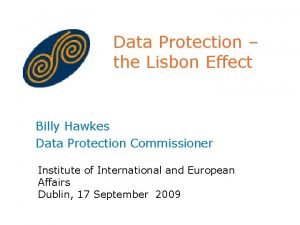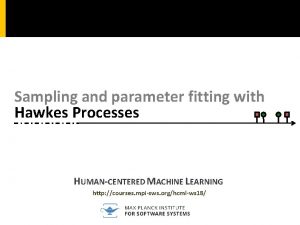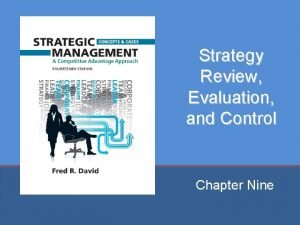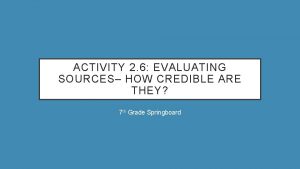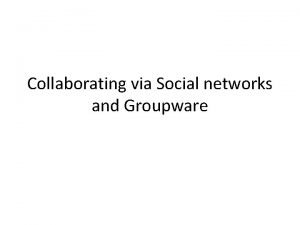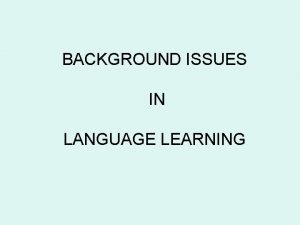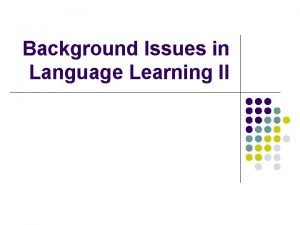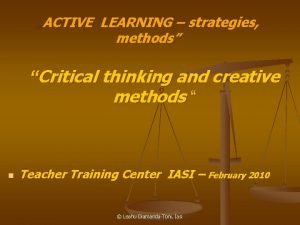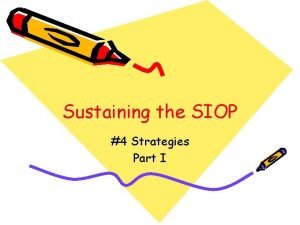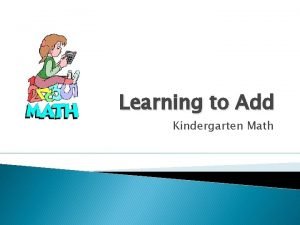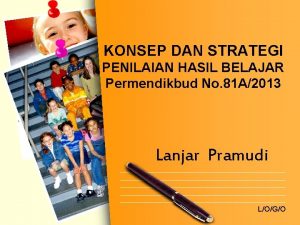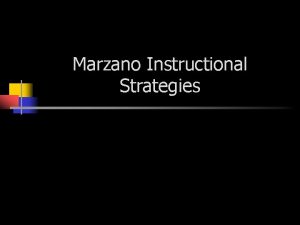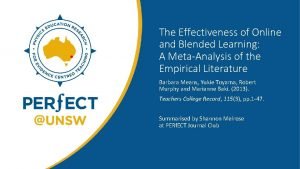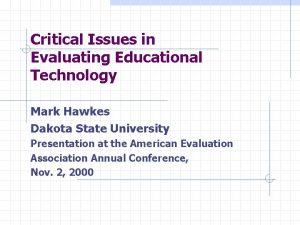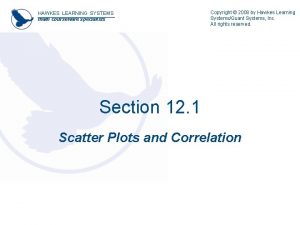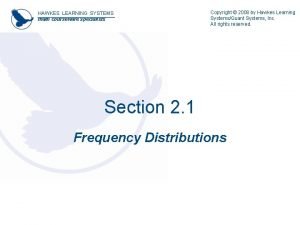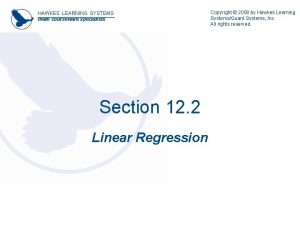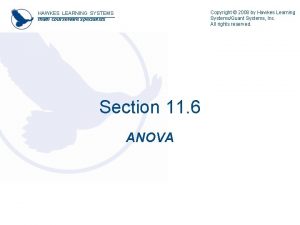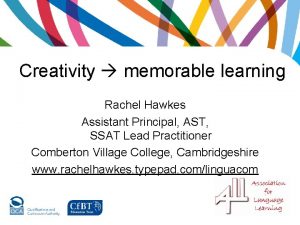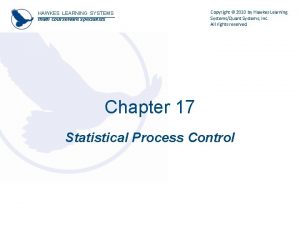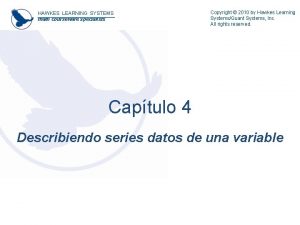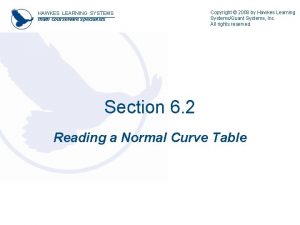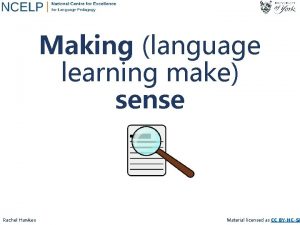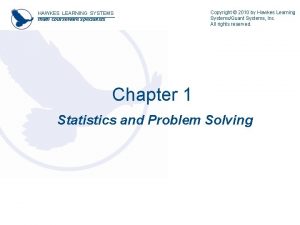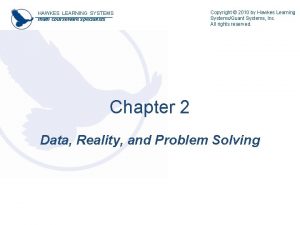Evaluating Online Learning Issues and Strategies Mark Hawkes





























- Slides: 29

Evaluating Online Learning: Issues and Strategies Mark Hawkes Dakota State University Innovations, Educating New Generations March 1, 2002

Presentation Objective Discuss online learning evaluation approaches in graduate programs at two universities Identify criteria/indicators suitable for the evaluation of online learning environments

Distance Learning Literature Evaluation. . . . No (79%) Yes (21%) Focus. . Training Education (87%) (13%) Impact on Learning. . . . No (58%) Yes (42%)

Instructor Student Online Learning Architect ure Internet Student Login Interface Content Resources Management and Organizational Information Communication Modes Assessment Institutional Support Services System Resources

Familiar Online Learning Evaluation Targets. . . interface design instructional design student satisfaction technology access faculty satisfaction economic viability departmental capacity interdepartmental collaboration

Common Dimensions of Effective Online Learning: Relevant and challenging assignments Providing adequate and timely feedback through teacher-student interaction Flexibility in teaching and learning Constructing coordinated learning environments Constructing rich environments for student to student interaction

DSU’s Educational Technology Program Students: 36 Credit hour MS program 80% Education (K 12, Technical, Higher Ed. ) 20% Business/industry 90% Online; 10% On campus Female 68%; Male 32% Project-based curriculum

DSU’s ET Environment Pervasive technological culture Consistency between program goals and the state/region-wide initiatives Campus-wide faculty support Institutional experience in Web-based instruction delivery Multi-delivery methods Client: teachers, teacher developers, instructors, trainers, technology coordinators, etc.

An Evaluation Model. . . Illuminative Operation of Components And Subcomponents Integrative Holistic perspective on The learning experience Components Infra- Course & Work structure Program Interaction Impact Flow /System Design Process Observing and Detecting Functional Problems Product Focused on Performance Outcomes

Infrastructure/System Input/output devices Network speed and connectivity Network design/Topology Technical support systems and maintenance

Course and Program Design Nature of the Design n n Situation Based Role of State and National Standards Sequencing/Instructional Strategies Assessment Motivation: Learning vs. Performance Visualization Tools and Media User Interface Course Management

Work Flow Use of discussion tools Software usage Message redundancy (audio, video, web pages, emails). Progression n n Do learners progress through their work tasks in a linear fashion? (novice-like) Nonlinear opportunistic fashion (expertlike)


Interaction Social and instructional Must account for all of the following relationships: Instructor Learners Technology Content

Interaction Example Learner Assessment Content Learning Resources (Technology) Performance Catalog info Instructor Query Learner Records Preferences (Metcalf, Snitzer, Austin,

Online Course Interaction Announcements Email Discussion Board (Web. Board Conferencing) Synchronous text chat Streaming media using Real Player Desktop Video File Loading Online assessment Audio/video clips Audio-narrated Power. Point's Room-based Video

Impact Course performance Collaborative learning Retention/attrition (course and program) Professional relevance and utility Learner productivity

Evaluation Attributes Multi-sourced data (students, server log files, etc) Internal and external Performance based Comparison and criterion based




The breadth of this course was: 1 2 3 Not nearly enough 4 5 6 The right amount 7 Way too much Compared to a traditional course 1 2 3 A much narrower range much wider range of of material was covered 4 5 6 7 About the same range A of material was covered Online: 4. 61 Compared to traditional 4. 65 n=32

The depth of this course was: 1 2 3 Not nearly enough 4 5 6 The right amount 7 Way too much Compared to a traditional course 1 2 3 4 5 6 7 Material was covered in much less depth about the same depth much more depth Online: 4. 48 Compared to traditional 4. 42 n=32

The extent of critical thinking required: 1 2 3 4 Not nearly enough Way too much 5 6 7 The right amount Compared to a traditional course 1 2 Much less 3 4 5 6 About the same 7 Much more Online: 4. 61 Compared to traditional 4. 94 n=32

The amount of effort put into the course: 1 2 3 4 Much less more 5 6 7 About the same Much Compared to a traditional course 1 2 Much less 3 4 5 6 About the same Online: 5. 65 Compared to traditional: 5. 26 n=32 7 Much more

Evaluation Processes Mostly formative Mixed data collection and analysis methods (document analysis, student artifact analysis, survey, interview, text analysis, etc. ) Course and program evaluation

Typical Problems with Online Courses Facilitating and encouraging collaboration Time management Student proficiency with course tools Ambiguous directions Timeliness of feedback

Factors Beyond ID Control Student sophistication with technology tools System capacity Learner availability/accessibility Enthusiastic, responsive instructor Good learner support Motivated learners

How to Design and Effective Online Course? Follow basic ID principals Build a climate of disclosure and full participation Institute informal student evaluation and check-in mechanisms Active and intensive instructor participation Build in as much interactivity as possible Create visually interesting screens/pages Ensure instructions are very clear Multi-mode interaction is critical Redundancy
 Sectoriapp
Sectoriapp Transformer hawkes process
Transformer hawkes process Hawkes bay refrigeration
Hawkes bay refrigeration Rumelt's criteria
Rumelt's criteria Most quantitative criteria are geared to
Most quantitative criteria are geared to Evaluating trading strategies
Evaluating trading strategies Activity 2 evaluating online resources
Activity 2 evaluating online resources Collaborating via social networks and groupware
Collaborating via social networks and groupware Chapter 7 strategic management
Chapter 7 strategic management Mis issues in strategy implementation
Mis issues in strategy implementation Implementing strategies: management and operations issues
Implementing strategies: management and operations issues Implementing strategies management and operations issues
Implementing strategies management and operations issues Implementing strategies management and operations issues
Implementing strategies management and operations issues Checklist for evaluating learning materials
Checklist for evaluating learning materials Cuadro comparativo e-learning m-learning b-learning
Cuadro comparativo e-learning m-learning b-learning Dse english electives
Dse english electives The miracle of language
The miracle of language Background issues in language learning
Background issues in language learning Inductive bias in decision tree learning
Inductive bias in decision tree learning Active learning strategies to promote critical thinking
Active learning strategies to promote critical thinking Classroom strategies for interactive learning
Classroom strategies for interactive learning Reactive discipline
Reactive discipline Language learning strategies
Language learning strategies Active learning strategies to promote critical thinking
Active learning strategies to promote critical thinking Siop strategies
Siop strategies Calla model
Calla model Assessment strategy
Assessment strategy Cognitive style
Cognitive style Marzano strategies
Marzano strategies The effectiveness of online and blended learning
The effectiveness of online and blended learning
